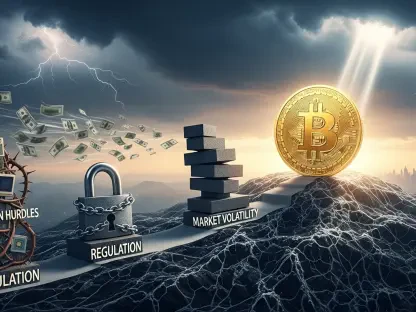In the ever-evolving landscape of digital finance, a transformative shift is underway that promises to redefine the very foundation of the cryptocurrency market. Tokenized Real-World Assets (RWAs) are emerging as a powerful force, bridging the gap between decentralized technology and traditional financial systems in a way that could fundamentally alter how value is perceived and exchanged in the crypto space. Unlike the speculative nature of many crypto-native tokens, RWAs tie digital assets to tangible, real-world value—think real estate, commodities, or government-backed securities—offering a stability that has long eluded much of the industry. This development is not merely a trend but a potential cornerstone for a more inclusive and credible financial ecosystem. As regulatory clarity improves and institutional interest grows, the integration of RWAs signals a departure from past volatility, inviting a closer examination of their broader impact on market dynamics and investor confidence.
Challenges of Traditional Token Models
The crypto market has long grappled with structural flaws in traditional token models that have undermined their appeal to serious investors. Many tokens, particularly altcoins, have consistently underperformed compared to Bitcoin, which continues to dominate market share while others face steep depreciation. A significant issue lies in the concentration of token allocations during private fundraising rounds, where early access is often restricted to a select few, leaving public investors exposed to price dumps post-launch. This imbalance erodes trust and highlights a disconnect between promised value and actual returns. Furthermore, the lack of clear revenue-sharing mechanisms means that even well-intentioned projects struggle to deliver measurable benefits to token holders, perpetuating a cycle of skepticism. As the market matures, these persistent challenges reveal a pressing need for reinvention, pushing the industry to seek models that prioritize transparency and equitable access over speculative hype.
Compounding these issues is the widespread misunderstanding of utility and governance tokens among investors. Often marketed as passive investment opportunities, these tokens typically require active participation—such as staking or liquidity provision—to accrue value, a nuance lost on many. This misalignment of expectations has led to disillusionment, as holders anticipate returns without engaging in the necessary ecosystem activities. Additionally, the absence of diversification in token offerings has confined much of the market to crypto-native assets, which are inherently speculative and volatile. Without ties to stable, real-world value, tokens struggle to establish themselves as credible long-term investments. The cumulative effect is a perception of risk that overshadows potential, limiting broader adoption. However, as the industry evolves, there is growing recognition that addressing these foundational flaws could unlock new pathways for stability and growth, setting the stage for innovative solutions like tokenized RWAs.
Regulatory Clarity as a Catalyst for Change
Regulatory advancements are playing a pivotal role in reshaping the crypto landscape, creating a framework that fosters trust and accountability. In regions like the European Union, the Markets in Crypto-Assets (MiCA) regulation is establishing legal standards for token fundraising, emphasizing transparency and expanding public access to early-stage opportunities. Similarly, the United Kingdom is implementing uniform standards across all token offerings, including unbacked crypto assets and security-style tokens, with measures like mandatory disclosures and market abuse controls. While these compliance requirements impose burdens on projects, they ultimately aim to filter out low-quality assets and elevate market integrity. This evolving regulatory environment is reviving the original spirit of initial coin offerings by prioritizing investor protections, paving the way for a more sustainable and credible token economy that can support transformative innovations.
Beyond establishing rules, these frameworks are addressing longstanding issues of access and fairness that have plagued token launches. By enforcing clear guidelines on asset dealing authorizations and public disclosures, regulators are ensuring that high-quality projects gain prominence while speculative ventures face greater scrutiny. This shift is crucial for rebuilding investor confidence, as it reduces the likelihood of price manipulation and hidden risks that have historically deterred participation. Moreover, the standardization of token offerings across jurisdictions creates a more predictable environment for developers and investors alike, encouraging cross-border collaboration. As these regulations take hold, they are not only mitigating past failures but also laying the groundwork for tokenized RWAs to thrive, offering a structured path for integrating real-world value into the digital asset space. The result is a market poised for greater legitimacy and broader appeal.
The Rise of Tokenized RWAs and Their Potential
Tokenized RWAs represent a groundbreaking shift in the crypto ecosystem, linking digital tokens to tangible assets governed by traditional financial systems. From real estate to government securities, these assets provide a stability that contrasts sharply with the volatility of crypto-native tokens, attracting interest from both private institutions and public sectors. Although still in early development, the momentum behind RWAs is undeniable as they offer a way to diversify investment portfolios beyond speculative digital assets. By tying token value to real-world collateral, they create a sense of security and measurable worth that has been largely absent from much of the market. This convergence of decentralized technology with established financial structures signals a future where tokens could become integral to global capital markets, provided current models are adapted to prioritize genuine value creation for holders.
The potential of RWAs extends beyond diversification, as they also facilitate greater inclusion in financial systems. By tokenizing assets like property or commodities, barriers to entry are lowered, allowing retail investors to access opportunities previously reserved for institutional players. This democratization of investment is complemented by the transparency inherent in blockchain technology, which ensures verifiable ownership and reduces fraud. Additionally, the growing involvement of governments in exploring tokenized offerings underscores the credibility of this trend, suggesting a future where digital and traditional finance seamlessly intersect. As adoption increases, the challenge lies in scaling these innovations while navigating regulatory complexities, but the direction is clear: RWAs are redefining tokens as foundational components of a broader economic framework, offering a glimpse into a more stable and interconnected financial landscape.
Building a Sustainable Future for Crypto
Reflecting on the journey of the crypto ecosystem, it’s evident that tokenized RWAs mark a turning point in addressing the shortcomings of traditional token models. Their integration brings a newfound stability by linking digital assets to tangible value, while regulatory frameworks in regions like the EU and UK provide the necessary guardrails to enhance market trust. These developments curb the speculative excesses of the past, fostering an environment where transparency and investor protection become paramount. The shift toward diversification through RWAs also broadens the appeal of digital assets, inviting participation from a wider audience. Looking ahead, the focus should center on scaling these innovations—ensuring that compliance evolves alongside technology and that access to tokenized opportunities expands globally. Collaboration between regulators, developers, and institutions will be key to sustaining this momentum, offering a blueprint for a crypto market that balances innovation with accountability.









